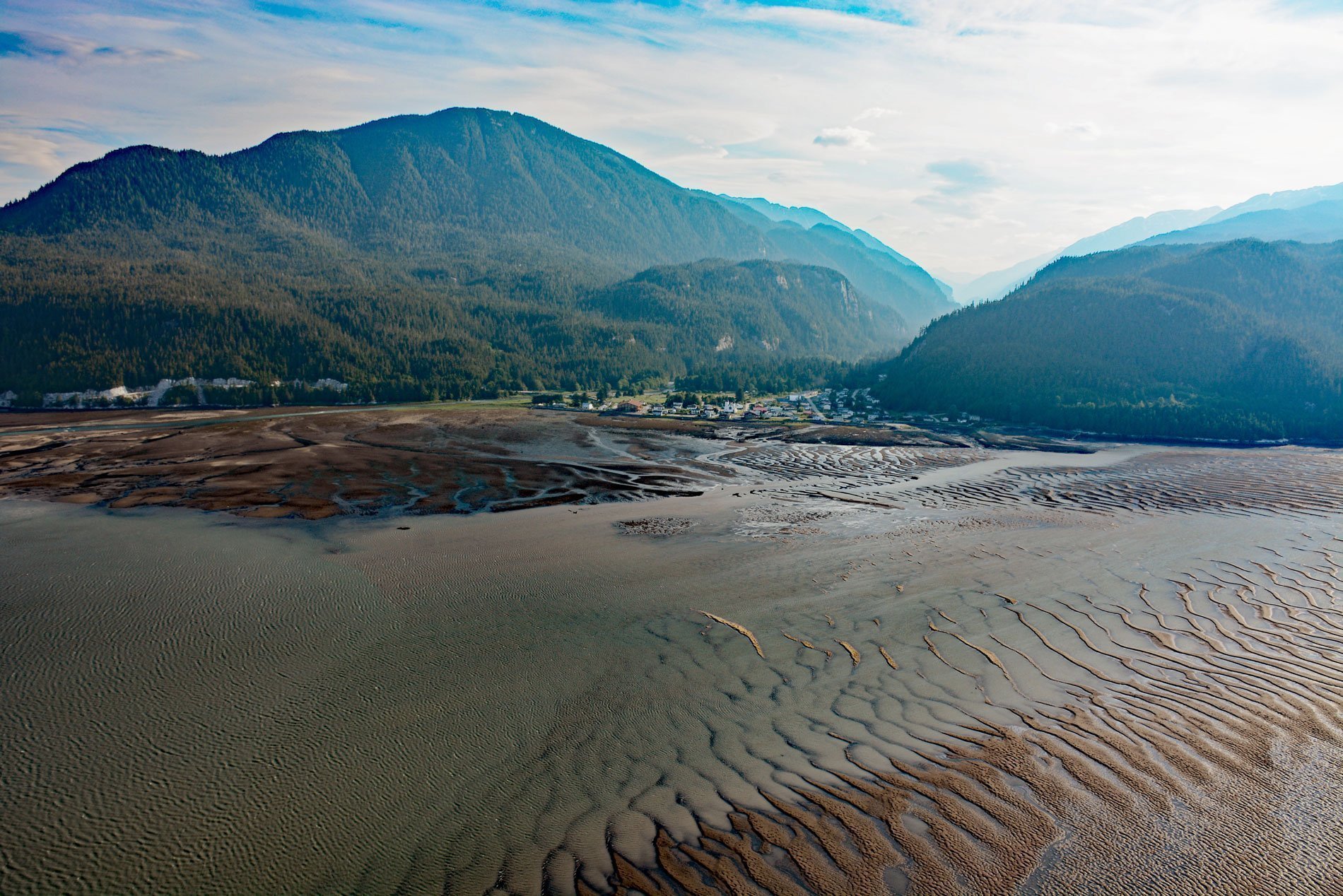Gingolx is one of four Nisga’a villages that make up the Nisga’a First Nation and is situated at the confluence of the Kincolith River and the Nass River on the northern shore of Nass Bay, about 70 miles (113 km) east-southeast of Ketchikan and 50 miles (80 km) north-northeast of Prince Rupert, British Columbia. The name Gingolx comes from the Nisga’a language meaning ‘place of scalps‘ and reputedly refers to the historical practice of hanging the scalps or skulls of enemies on poles to ward off intruders. The Kincolith River starts from several deglaciated cirques at an elevation of about 4,700 feet (1,433 m) and flows generally southwest for 27 miles (43 km) to Nass Bay. The watershed drains the southern extent of the Boundary Ranges in the Coast Mountains. The underlying bedrock is mostly granitic intrusions that are remnants of a Late Cretaceous volcanic arc system called the Coast Range Arc that formed as a result of the Kula and Farallon Plates being subducted under the North American Plate. It is the largest granitic outcropping in North America and extends from northern Washington in the south to the Yukon in the north. The subduction of the oceanic plates caused magma to rise from the oceanic Farallon Plate and be injected into older igneous rocks of the continental Insular Belt creating a continental volcanic arc about 100 million years ago. Volcanism began to decline along the length of the arc about 60 million years ago and shut down about 50 million years ago. Many of the volcanoes have since disappeared from erosion and what remains of the Coast Range Arc are outcrops of granite formed when magma intruded and cooled at depth beneath the volcanoes. The eroded watershed of the Kincolith River has exposed granodiorite that forms the present-day Coast Mountains.
The Nass River starts in the Skeena Mountains of the Coast Range and drains a watershed of about 5 million acres (2 million ha) and flows southwest for 240 miles (380 km) to Nass Bay which connects to the North Pacific Ocean via Portland Inlet and Dixon Entrance. The lower 25 miles (40 km) of the Nass River are navigable and the river supports important runs of Chinook, chum, coho, pink, and sockeye salmon that created a rich and complex history of human settlement. Nass is the English name for the river derived from the Tlingit word ‘Naas’ which means ‘intestines’ or ‘guts’ presumably in reference to the river as an important source of food. The Nisga’a name for the river is ‘K’alii Aksim Lisims’ or ‘Lisims Valley’, where ‘Lisims’ means ‘murky’ referring to the heavily silt-laden water. The Nisga’a language is spoken along the Nass River and is linguistically related to Tsimshian; however, the Nisga’a people consider themselves ethnically separate from the Tsimshian. The name Nisga’a is from the Tlingit language meaning ‘people of the Nass River’. They were historically a subsistence culture relying on hunting, fishing, and plant gathering. Some traditional foods included crabs, black cod, halibut, salmon, herring eggs, seals, sea lions, clams, pine mushrooms, lowbush cranberries, and mountain blueberries. They traveled by canoe and on foot to hunt and fish on their territories and to trade with neighboring Indigenous Peoples. The Nisga’a lived in rectangular-shaped plank houses made of cedar wood. The archaeological record suggests that after thousands of years of human settlement a cultural change was initiated about 2,500 years ago when newcomers arrived from the interior or from the north. At first, these migrants were incorporated into existing Tsimshian communities resulting in conflict and the emergence of social class distinctions. Eventually, the pressures of increased populations through internal growth and migrations culminated in a period of warfare with the Tlingit from the north and east and the temporary abandonment by ancestral Tsimshian of their coastal territory. This conflict had two phases, an initial period about 1,900 years ago when the coastal Tsimshian retreated to the interior river valleys and a final period about 1500 years ago when an alliance of coastal and interior Tsimshian returned to the coast and drove out the Tlingit.
The site of Gingolx has been inhabited on a seasonal basis for thousands of years by clans of the Nisga’a. The village was extremely isolated and before contact with Europeans, the Daaxan, or the Killer Whale clan, inhabited the eastern side of the village, and the Gitxun, or Eagle clan, inhabited the western side of the village. The modern village of Gingolx was founded in 1867 by Robert Doolan and Robert Tomlinson and modeled after the Christian settlement of Metlakatla where William Duncan was the founder and leader. The first European-style buildings included a church and school built in 1879. Today, the community has four clans including Killer Whale, Eagle, Raven, and Wolf. The Kincolith Hatchery is located at the mouth of the Nass River, is owned by the Nisga’a and operated by the Nisga’a Lisims Government. The hatchery was built in 1978 to rebuild the Kincolith River chinook population to historic levels and increase the production of coho for the sport, commercial, and subsistence fisheries. From 1980 to 1996, the hatchery produced a combination of coho and Chinook. Coho production was terminated in 1996 due to excess stock, and chum became the hatchery’s second species. Chum were reared from 1991 to 1994 with the broodstock coming from the Stagoo River. The production of Chinook and chum was the focus of the project from 1996 to 2004. In 2005, the project reduced the production of Chinook and incorporated a weir on the Kincolith River to assess fish escapement. In 2003, a road 17 miles (28 km) long was completed from Gingolx to Greenville which also connected Gingolx to the Nisga’a communities of New Aiyansh and Canyon City. This road, the Kincolith Extension Highway, links Gingolx to the Nisga’a Highway with connections to the Yellowhead and Cassiar Highways. Read more here and here. Explore more of Gingolx and Kincolith River here:

